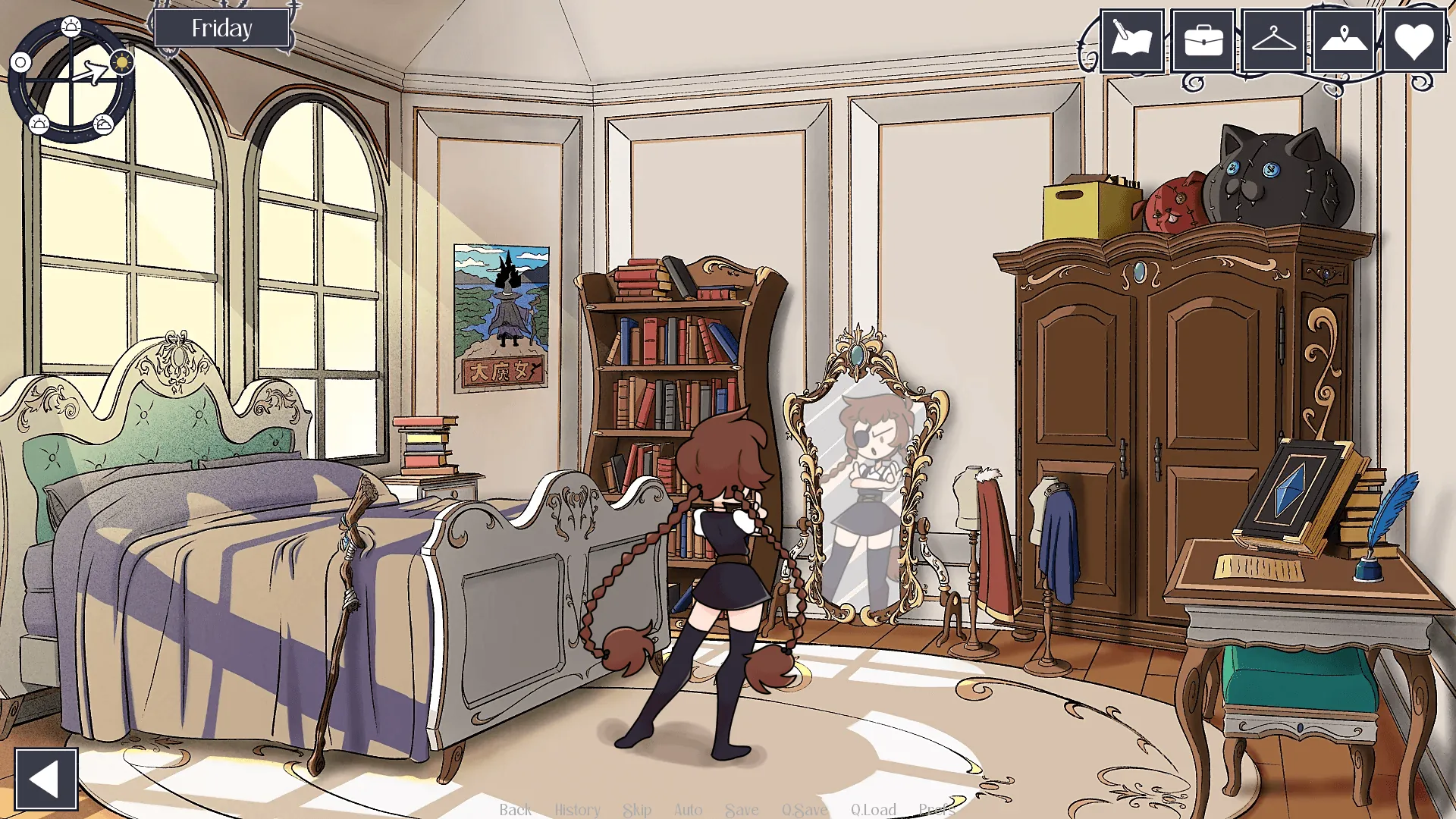
Dreaming of Dana
Play Dreaming of Dana
Dreaming of Dana review
Master character relationships, unlock all scenes, and navigate family dynamics in this narrative-driven simulation
Dreaming of Dana stands out as a narrative-driven simulation that blends family drama with romance and ambition. Players step into the shoes of a privileged protagonist navigating complex family expectations while pursuing personal desires and romantic connections. The game’s engaging character development and intricate relationship system create multiple pathways through the story, making each playthrough unique. Whether you’re new to the game or looking to unlock all available content, understanding the mechanics behind character affection, sexuality points, and decision-making is essential. This guide explores everything you need to know about maximizing your experience in Dreaming of Dana.
Understanding Dreaming of Dana’s Core Mechanics
Ever found yourself completely invested in a virtual relationship, carefully considering every word you say, only to be blindsided by a character’s cold shoulder? 😮 I certainly have. That moment of panic, scrambling through save files to figure out where it all went wrong, is exactly what makes Dreaming of Dana so compelling. This isn’t just a game you play; it’s a world you inhabit, and your Dreaming of Dana choices matter more than you might initially think. The game’s intricate systems are the hidden engines driving every interaction, and understanding them is the key to unlocking the rich, branching narratives you’re meant to experience. 🗝️ Let’s pull back the curtain.
### How Character Affection and Sexuality Points Work
At the heart of Dreaming of Dana’s emotional landscape are two interconnected systems: affection points and sexuality points. Think of them as the game’s way of keeping a detailed, nuanced scorecard of your social performance. 🧮
Dreaming of Dana affection points are the primary measure of your relationship health with each character. They represent trust, friendship, and romantic interest. A high affection score with Dana, for instance, means she enjoys your company and is opening up to you. Conversely, low affection can lead to locked dialogue, missed opportunities, and even story paths that end prematurely. 😥 These points are earned through consistent, character-appropriate choices. Remembering a detail she shared earlier, supporting her in a disagreement, or simply choosing to spend time with her are all reliable ways to boost this meter.
Now, let’s talk about the sexuality points mechanics. This system is more subtle but equally powerful. It doesn’t just track who you’re attracted to, but also how you express that attraction and your character’s confidence in their own skin. 🦋 Your choices—from flirtatious dialogue options to your reactions in intimate moments—slowly define your protagonist’s sexual persona. This score acts as a key, unlocking specific scenes and dialogue branches that are only available to a character who is comfortable and expressive in a certain way. A player who accumulates points in a more reserved, tender direction will see different options than one who pursues a bold, dominant path.
The real magic happens in the interplay between these two systems. You can’t just max out Dreaming of Dana affection points and expect to see everything. Many of the game’s most memorable scenes require a specific combination of high affection and a sufficiently developed sexuality score. It’s a brilliant design that ensures your character’s personal growth is just as important as your relationships with others.
Pro Tip: Don’t try to be everything to everyone on your first playthrough. The game rewards specialization. Pick a character (or two) and a personality archetype for your protagonist, and stick with it consistently to see the deepest content.
### Decision-Making and Story Branching System
If the points are the scorecard, then the decision branching walkthrough of your experience is written by every single choice you make. This is where the famous “Dreaming of Dana choices matter” philosophy truly comes to life. The game is less a straight path and more a sprawling tree, where even a seemingly insignificant decision in Chapter 1 can cause a major branch to grow—or be cut off—by Chapter 5. 🌳
The framework isn’t just about big, dramatic “YES or NO” moments. It’s woven into the fabric of everyday conversation. How you choose to comfort someone, the jokes you make, or even who you decide to sit with at lunch can set off a chain reaction. I learned this the hard way on my first playthrough. I made what I thought was a harmless, sarcastic comment to Dana’s brother early on. I forgot about it completely until hours later, when he refused to help me in a critical situation, referencing that earlier “joke” as a sign that I wasn’t trustworthy. My jaw literally dropped. 🤯 The game remembers.
This character relationship system is built on cause and effect. The game tracks your alignment across three primary character attributes: Nice, Jerk, and Manly. These aren’t just labels; they are numerical values that influence which dialogue options are available to you and how characters perceive your actions. A “Jerk” action might lower your Nice points but could potentially raise your Manly points, depending on the context.
Here’s a practical look at how different dialogue choices can shape your protagonist’s core attributes:
| Scenario | Nice Choice & Points | Jerk Choice & Points | Manly Choice & Points |
|---|---|---|---|
| Dana is struggling with a heavy box. | “Let me help you with that.” (+Nice) | “Looks like you’ve got it.” (+Jerk) | “Step aside, I’ve got it.” (+Manly) |
| A friend is feeling insecure. | “I’m here for you, no matter what.” (+Nice) | “You need to toughen up.” (+Jerk) | “Let’s go work out, it’ll help.” (+Manly) |
| You’re challenged to a game. | “Let’s just have fun!” (+Nice) | “You don’t stand a chance.” (+Jerk) | “You’re on. Let’s make it interesting.” (+Manly) |
Your chosen path directly impacts your relationship progression tips. A “Nice” path might unlock supportive, tender scenes with Dana, while a “Manly” path could lead to more competitive, physically-oriented interactions. The beauty is that no single path is “correct”—they simply lead to different versions of the story and different facets of the characters. This is the core of the decision branching walkthrough; you’re not just guiding a story, you’re building a personality.
### Unlocking Hidden Scenes and Content
This is the payoff for mastering the systems—the glorious moment when your careful planning unlocks a scene you didn’t even know existed. 🎉 The scene unlocking guide aspect of Dreaming of Dana is all about meeting specific thresholds. It’s not about picking the single right option, but about consistently building your character and relationships to a point where new doors naturally open.
Most hidden scenes are gated behind a combination of three factors:
1. A minimum level of Dreaming of Dana affection points with a specific character.
2. A minimum score in your sexuality points mechanics for a particular expression (e.g., “Confident” or “Romantic”).
3. A key story choice that you made earlier in the game.
For example, to unlock the “Moonlit Conversation” scene with Dana, you might need:
* Affection with Dana: 75+ points
* Sexuality (Tender): 40+ points
* Story Prerequisite: You must have chosen to defend her during the family argument in Chapter 3.
If you miss any one of these requirements, the scene simply won’t trigger. The game won’t tell you what you missed; the opportunity will just pass you by. This makes subsequent playthroughs feel fresh and rewarding, as you actively work towards these specific combinations.
So, how can you efficiently experience as much content as possible? Here are my top relationship progression tips for a comprehensive playthrough:
- Focus is Key: 🔑 On any given playthrough, dedicate yourself to one or two primary love interests and one primary personality archetype (e.g., “Nice & Tender” or “Manly & Confident”). Spreading your points too thin is the fastest way to miss the best scenes.
- Listen Actively: Characters will often drop hints about their likes, dislikes, and past experiences. Write them down! Choosing a dialogue option that references something a character told you earlier is a massive boost to affection.
- Embrace Flaws: You don’t always have to say the “perfect” thing. Sometimes, making a mistake or having a minor disagreement can lead to a unique reconciliation scene that’s just as meaningful as a flawless victory.
- Strategic Saving: 💾 Don’t be ashamed to save before major conversations. This allows you to experiment with different responses to see their immediate point impact without committing to a full new playthrough.
FAQ: Common Questions about Scene Unlocking
Q: I have high affection but still can’t unlock a specific scene. What am I missing?
A: This is almost always due to the sexuality points mechanics. High affection gets your foot in the door, but you need the right “key” from your sexuality score. Check the tone of the scene you’re trying to unlock—does it require a “Bold” or “Tender” approach? Adjust your flirtation and intimate choices accordingly.
Q: Is it possible to see all scenes in one playthrough?
A: Absolutely not, and that’s by design! 🙅♂️ The game’s decision branching walkthrough is built for replayability. Trying to unlock everything in one go will result in a middling, unfocused character who doesn’t qualify for the high-tier scenes for any specific path. Embrace the specialization.
Q: What’s the most efficient way to farm affection points?
A: Consistency. The character relationship system rewards steady, reliable behavior more than grand, one-off gestures. Always choose to spend time with your target character when given the option, and align your dialogue with their personality and your chosen archetype.
Mastering the core mechanics of Dreaming of Dana transforms it from a simple visual novel into a deep, reactive role-playing experience. By understanding the delicate dance between Dreaming of Dana affection points and the sexuality points mechanics, and by respecting the weight of every choice in the decision branching walkthrough, you move from being a passive reader to an active architect of your own unique story. Use this scene unlocking guide and these relationship progression tips as your blueprint, and get ready to build something unforgettable. 🏡
Dreaming of Dana offers a rich experience for players who appreciate narrative depth and meaningful choices. By understanding how affection and sexuality points interact with your decision-making, you can craft a personalized story that reflects your preferred playstyle. The game rewards experimentation and careful attention to character preferences, making each relationship feel earned rather than automatic. Whether you’re pursuing a specific romantic path or aiming to unlock all available content, the systems discussed in this guide provide the foundation for success. Take your time exploring different dialogue options, pay attention to how characters respond to your choices, and remember that the most rewarding moments come from understanding what each character truly values. Your journey through Dreaming of Dana is uniquely yours—make it count.












